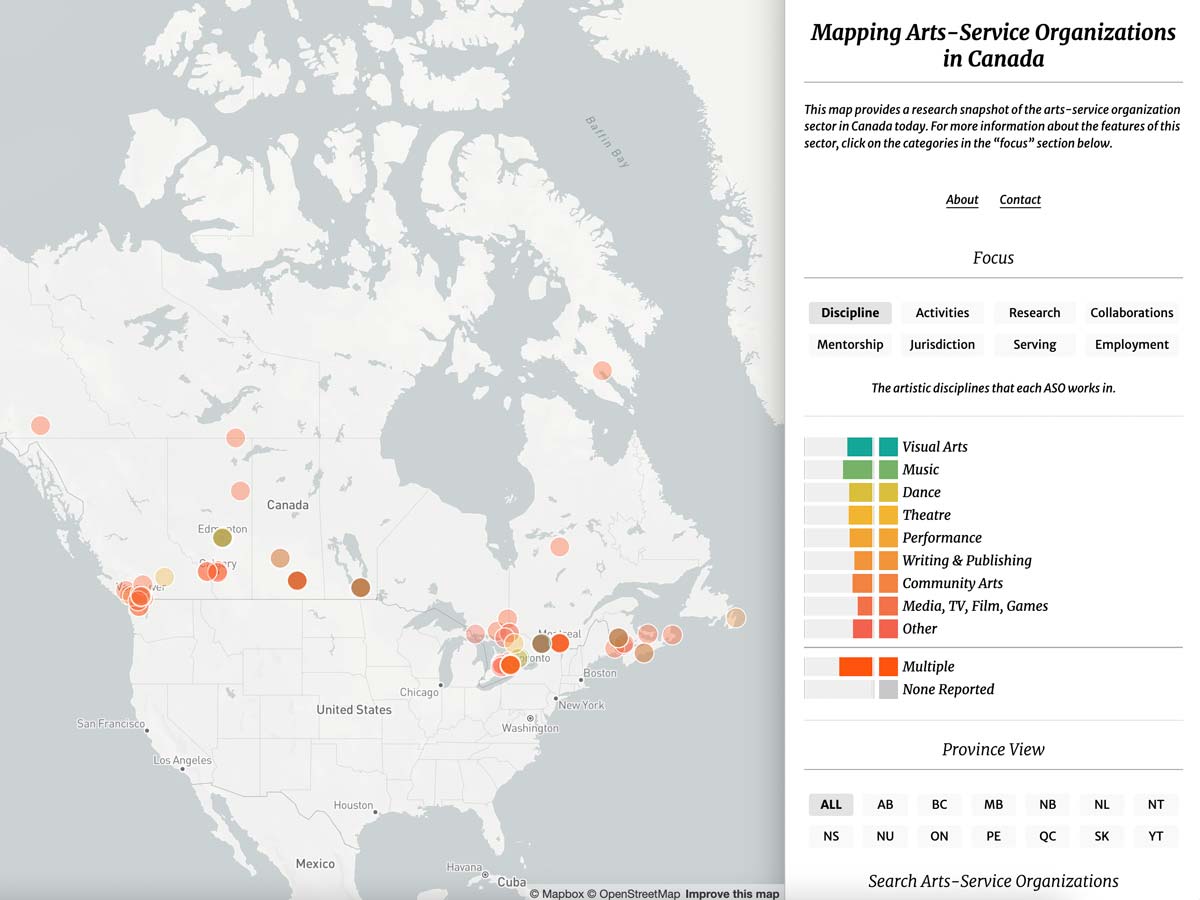Transformation through collaboration: Connections for a shared world
Innovation Issue 37: Fall 2022
Mapping the arts: How a digital map fosters connection and collaboration
Culture
Mapping the arts: How a digital map fosters connection and collaboration
From a national organization advocating for greater visibility and financial support for the live music industry to a small grassroots organization offering mentorship and networking opportunities for writers, arts service organizations (ASOs) provide crucial support for Canadian artists. However, their work often remains invisible both to those outside the arts and within the sector itself.
Toronto Metropolitan University (TMU) Creative Industries professor Miranda Campbell and research-focused arts support organization Mass Culture embarked on a collaborative, multi-focused research project to highlight the work of ASOs across Canada. One outcome of their research is a digital map that not only creates a picture of services available to artists but also helps ASOs find other local organizations so they can connect, collaborate and share resources instead of competing for them.
“Often people in the arts are working in silos or are facing their own internal pressures,” said professor Campbell, explaining how many ASOs operate with limited funding and little to no full-time staff. “Our research tries to document the sector so that it better knows itself and better knows its own strengths and capacities.”
Using The Creative School professor's academic knowledge and Mass Culture’s experiential knowledge of the ASO sector, the team conducted a quantitative survey to gather information about the organizations that exist in Canada and to better understand the supports they provide, such as research, marketing, advocacy and development training. Targeted outreach ensured representation from ASOs across each province and territory as well as Indigenous ASOs and those working with equity-seeking groups.
 TMU professor Miranda Campbell and Mass Culture developed an interactive digital map of arts service organizations across Canada. The map is publicly available on Mass Culture’s website.
TMU professor Miranda Campbell and Mass Culture developed an interactive digital map of arts service organizations across Canada. The map is publicly available on Mass Culture’s website.
The information was plotted on a digital interactive map (external link, opens in new window) of ASOs across Canada, which lays out the diversity of the sector from grassroots and local organizations to provincial and federal organizations. The map is available to both ASOs and the public on Mass Culture’s website.
The second part of the research project examined ASOs social and cultural significance and allowed the research team to learn about the strategies ASOs use for social change and engagement.
“We might not always celebrate them within the larger innovation-driven creative industries ecosystem, but ASOs are innovative in their social engagement strategies,” said professor Campbell.
The researchers found that ASOs foster diverse representation by creating meaningful relationships with Indigenous communities, newcomer communities and communities of people from underrepresented groups to move beyond tokenism. Strategies include sponsoring and creating value-based hiring practices, collaborating with other organizations to reach new communities and offering more diverse programming. The researchers also found that ASOs are trying to commit to ongoing learning and reflexivity to foster social change within their organizations.
“This is an important sector in Canada to take note of that has strength in innovation, especially in social and cultural impact,” said professor Campbell.
Overall, the goal of professor Campbell’s and Mass Culture’s research was to support the ASO sector in terms of gaining more appreciation, recognition, support and funding while also establishing a foundation for continued academic research and collaboration.
This is an important sector in Canada to take note of that has strength in innovation, especially in social and cultural impact.

Read “Making community knowledge visible: Mapping Canadian arts-service organizations as cultural research conduits (opens in new window) ” in the Canadian Journal of Communication.
Read “Strategies for social engagement: Arts-service organizations as organizational intermediaries (external link, opens in new window) ” in Poetics.
Read more of professor Campbell’s research on the social impact of the creative industries in her book Reimagining the Creative Industries (external link, opens in new window) .
Support for this project was provided by the Social Sciences and Humanities Research Council of Canada.
